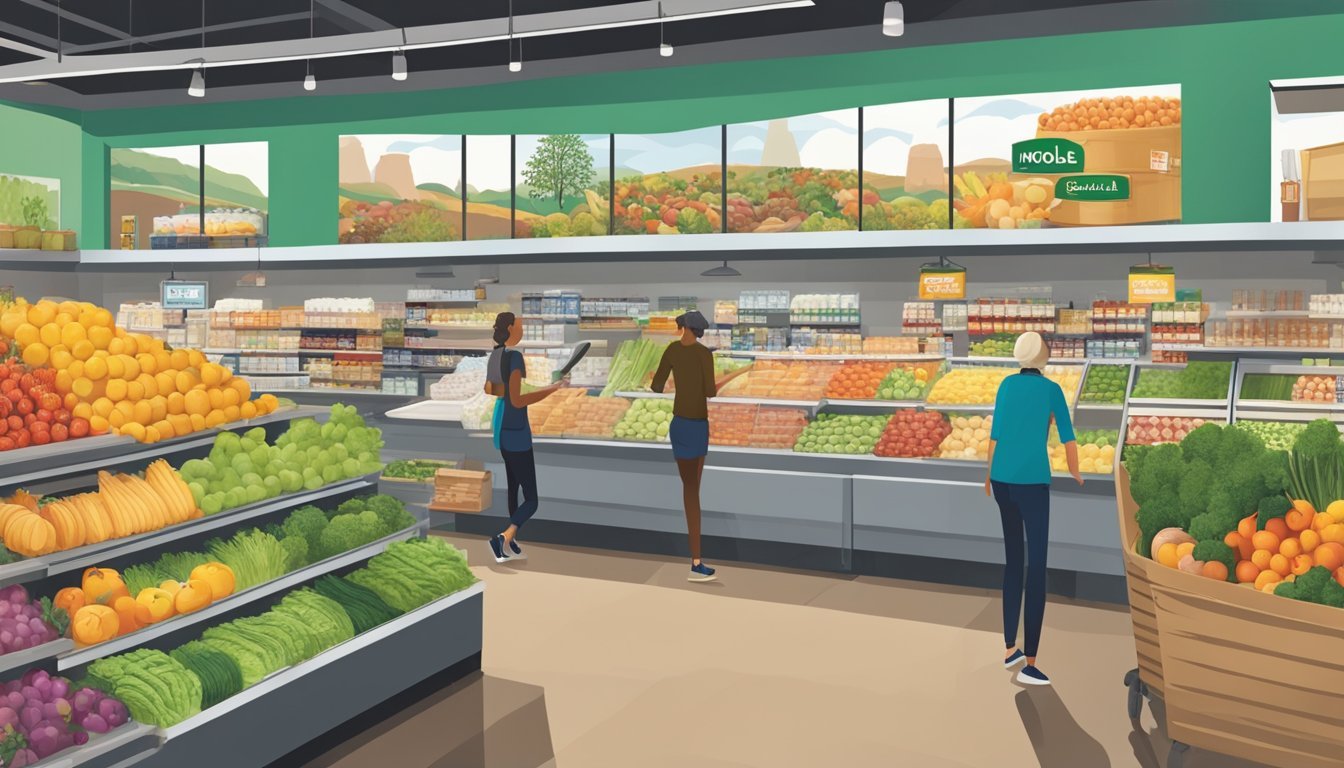Whole Foods Market vs Lidl
Comparing Shopping Experiences and Value
Part of Our Grocery Store Guide with Details on Whole Foods Market Prices and Lidl Prices
In the landscape of grocery shopping, two stores often come to mind for those seeking both quality and value: Whole Foods Market and Lidl. Whole Foods Market, well-known for its range of organic and natural products, positions itself as a leader in healthier grocery options. Its reputation for higher quality items, including a robust selection of organic produce and its own 365 by Whole Foods Market brand, attracts a specific customer base that prioritizes nutritious choices and eco-friendly practices.
Lidl, on the other hand, has made a name for itself as a budget-friendly grocery option without compromising on quality. Originating in Germany and expanding across Europe and into the United States, Lidl boasts significant savings on a variety of items, challenging even well-established discount retailers. Shoppers often find Lidl's prices to be lower than those of traditional grocery stores, providing a competitive edge for the cost-conscious consumer.
Comparing Whole Foods Market and Lidl presents an intriguing study of the grocery industry's spectrum: from upscale, health-conscious offerings to economical, value-driven purchases. Consumers weigh factors such as product range, store organization, pricing, and quality when deciding where to invest their grocery budget. Each store serves different shopper priorities, from environmental concerns and dietary needs to household budgeting and convenience, reflecting the diverse demands of the modern consumer.
Brand Overview
In the competitive grocery market, Whole Foods Market and Lidl stand out as prominent players, each with a distinct history and growth trajectory. Their evolution reflects changing consumer preferences and the dynamic nature of the retail food industry.
History of Whole Foods Market
Whole Foods Market began its journey in 1980 when John Mackey and Renee Lawson Hardy opened a small natural foods store in Austin, Texas. Their mission was to offer natural and organic foods to a growing consumer base seeking healthier options. Over the years, Whole Foods expanded beyond Austin, opening more stores and acquiring other natural foods chains. By emphasizing quality organic products and an upscale shopping experience, Whole Foods positioned itself as a leader in the premium grocery segment. In 2017, it became a subsidiary of Amazon, further transforming the grocery landscape by integrating e-commerce and brick-and-mortar operations.
The Rise of Lidl
Lidl, on the other hand, has roots in 1970s Germany and was founded by Dieter Schwarz. It started as a discount supermarket chain, part of the Schwarz Gruppe. Lidl's rapid expansion across Europe and later into the United States has been fueled by its business model of offering high-quality products at low prices. The store's straightforward layout and a rotating selection of non-grocery items have contributed to its popularity. With a significant presence in over 30 countries and a growing total of stores, Lidl demonstrates how a discount business model can disrupt the traditional grocery store concept.
Store Philosophy and Target Demographic
When choosing a grocery store, shoppers often consider two crucial aspects: the store's philosophy and the demographics it targets. These factors significantly influence the shopping experience, as each store aims to cater to its unique audience.
Whole Foods Market's Mission
Whole Foods Market operates with a clear focus on natural and organic food. It positions itself as more than just a grocery retailer; it's an advocate for environmental stewardship and healthy living. Whole Foods Market appeals to customers who prioritize quality products, sustainability, and a healthy lifestyle. According to demographic data, its typical customer is likely a millennial, educated, and has an annual income of over $80,000. These customers might include individuals, as well as families seeking organic and responsibly-sourced products.
Lidl's Approach to Grocery
Lidl takes a different strategy in the grocery sector by offering high-quality goods at low prices. It emphasizes efficiency, a limited selection of private-label brands, and a streamlined shopping experience. This appeals to a broad demographic, inclusive of value-conscious customers, families, and those with special dietary restrictions. Lidl answers the needs of a diverse clientele base looking for affordability without compromising on quality.
Location and Accessibility
When considering where to shop for groceries, the location and accessibility of the store are paramount. Whole Foods Market and Lidl offer different geographical footprints, with Whole Foods having a widespread presence in the U.S. and Lidl focusing on the East Coast.
Expansion of Whole Foods Stores
Whole Foods Market is a well-established grocery chain in the United States, known for its organic and natural food offerings. Their stores are predominantly found throughout the country, with a significant presence in both urban and suburban areas. The expansion strategy of Whole Foods has allowed it to tap into various markets, making it accessible to a wide demographic.
Number of Whole Foods locations: Over 500 stores across North America and the United Kingdom.
Lidl's Presence on the East Coast
Lidl, a German-based discount grocery chain, has been expanding its presence on the East Coast of the United States. While it started with a smaller number of locations, its strategic opening of new stores has increased its accessibility to customers in this region.
Focus Area: Mainly East Coast of the United States.
Store Count: More than 150 stores and growing rapidly on the Eastern seaboard.
The footprint of Lidl is still smaller compared to Whole Foods but is rapidly increasing, with a plan to serve more regions across the country.
Product Selection and Quality
When evaluating Whole Foods Market and Lidl, consumers will find distinct differences in product selection and quality. Whole Foods Market prides itself on a wide variety of organic and national brand products, while Lidl offers a diverse range of goods including fresh produce and private-label options.
Exclusive Products at Whole Foods Market
Whole Foods Market has established itself as a leader for organic produce and exclusive offerings, including its private-label line, 365 by Whole Foods Market. Shoppers can find a plethora of organic options, from pantry staples to snacks. Additionally, the store's emphasis on quality often means carrying products that are non-GMO and free from artificial preservatives.
Lidl's Diverse Range of Goods
Lidl's strength lies in its variety, encompassing not only groceries but also a selection of household items, clothing, and seasonal products. The store pairs its expansive private-label selection with national brands, providing a broad spectrum of quality choices for shoppers. Lidl's larger store sizes typically allow for an assortment that can cater to a wide range of needs and preferences.
Comparing Fresh Produce
The fresh produce section is a focal point for both Whole Foods Market and Lidl. Whole Foods Market's produce is often touted for its quality and organic options. Lidl, on the other hand, has gained recognition for its affordable prices while still maintaining a competitive edge in quality, giving consumers value for their money.
Organic and Private-Label Options
Both retailers offer an assortment of organic options. Whole Foods has a long-standing reputation for being a destination for organic food lovers, while Lidl has increased its offerings of organics to align with consumer trends. In terms of private-label items, Whole Foods Market's 365 brand is synonymous with quality, whereas Lidl's private-label goods are regarded for their affordability and variety, challenging the quality ratio of more expensive counterparts.
Store Layout and Shopping Experience
In comparing Whole Foods Market and Lidl, the store layout and shopping experience are notably distinct. Whole Foods Market emphasizes an upscale, organic atmosphere, while Lidl offers a streamlined, budget-friendly environment.
Navigating Whole Foods Market
Whole Foods typically operates larger stores, with clear signage that guides shoppers through various sections dedicated to organic and natural foods. Its aisles are wide and well-organized, accentuating a spacious shopping experience. Each store is designed to provide a sense of abundance and variety, often including specialty areas such as a bakery, deli, and hot food bars. Here, customers can find not just groceries but also experiential sections like in-house dining and cooking demonstrations.
Signage: Prominent and informative, aiding in easy navigation.
Square Feet: Larger floor plans, offering an extensive array of products.
The Lidl Shopping Environment
Lidl stores are generally more compact than Whole Foods but are laid out efficiently to maximize retail space. The stores ensure a straightforward shopping experience, with a simplistic store design that minimizes overwhelming choices. Lidl focuses on private-label items and limited-time deals prominently displayed in the center aisles. Their layout is designed for quick in-and-out shopping, with less emphasis on in-store experiences and more on finding daily essentials at an affordable price.
Signage: Functional and less prominent, reflecting its streamlined approach.
Square Feet: Smaller but optimized for easy-to-find deals and essentials.
Pricing and Value
When weighing the advantages of Whole Foods Market against Lidl, customers often consider pricing and the value for their money. Whole Foods Market offers a premium selection of goods, often organic and high-quality, while Lidl focuses on providing a cost-efficient shopping experience without compromising on quality.
Whole Foods Market's Value Proposition
Whole Foods Market caters to a demographic seeking premium products, particularly organic and specialty items. The store's pricing reflects its high-quality offerings and commitment to sustainability. Prices at Whole Foods are typically higher than average supermarket prices, but customers are paying for the value which encompasses product quality, ingredient transparency, and ethical sourcing. Their 365 brand, for instance, provides a range of products that promise a better nutritional profile and quality.
Lidl's Competitive Pricing Strategy
Lidl operates with a different strategy, prioritizing low sale prices to attract a broader customer base. This company has been recognized for its ability to maintain a balance between quality and cost-effectiveness. Lidl keeps prices low through a limited selection of items, which allows for bulk purchases and significant discounts from suppliers. These savings are passed on to customers, with sale prices often placed prominently in-store to highlight the savings. Lidl's cost savings extend to a range of products, including fresh produce and packaged goods, adhering to the store's objective to offer lower prices without sacrificing quality.
Customer Service and Satisfaction
In the competitive grocery store industry, customer service and satisfaction are pivotal metrics for success. Whole Foods Market and Lidl, despite their differing market positions and strategies, prioritize these aspects to cultivate loyal customer bases.
Service Quality at Whole Foods Market
Whole Foods Market has built a reputation for high service quality, an achievement corroborated by its ranking in Consumer Reports’ grocery store ratings, where it often receives high marks for customer satisfaction. Employees at Whole Foods are known for their knowledge about products and willingness to assist customers. In-store experiences are characterized by a clean environment, ample product information, and a hands-on approach to customer service.
Lidl’s Commitment to Customer Care
Lidl, on the other hand, demonstrates its commitment to customer care through a more streamlined shopping experience. It maintains a focus on simplicity and efficiency, leading to a straightforward and hassle-free shopping experience for customers. Lidl’s service can be typified by fast checkout lines and easy-to-navigate store layouts, which enhance overall shopping satisfaction despite the stores' more limited staff presence compared to Whole Foods.
Additional Services and Features
When comparing Whole Foods Market and Lidl, it is worth exploring their additional services and features that enhance the shopping experience. Each store offers unique selections and specialized services that cater to specific customer preferences.
Whole Foods Market's Specialty Sections
Whole Foods Market distinguishes itself with an array of specialty sections. Their bakery section is renowned for its assortment of fresh bread, pastries, and cakes, many of which are organic or gluten-free. The store prides itself on providing a vast selection of alcohol, including local and international beer and wine options. The coffee range is also impressive, with Whole Foods often featuring in-house roasting and a variety of organic and fair-trade beans.
Lidl's Unique Offerings
Lidl stands out with its approach to chocolate and coffee, providing a rich selection that includes fair-trade and single-origin options. Their emphasis is on high quality at affordable prices. Moreover, Lidl's rotating "Special Buys" section features unique items that aren't typically found in grocery stores, from seasonal goods to household items, adding an element of surprise to each visit.
Sustainability and Corporate Responsibility
In the modern grocery landscape, sustainability and corporate responsibility are not just buzzwords but are integral to business strategies. Whole Foods Market and Lidl showcase this commitment through their impactful practices and goals.
Whole Foods Market’s Ethical Practices
Whole Foods Market has taken significant strides in sustainability, focusing on reducing its carbon footprint and combating food waste. The retailer has implemented a strategic approach that includes the sourcing of products with environmental consideration and supporting the growth of their team members. An annual Impact Report lays out their achievements and future goals, underlining a comprehensive drive towards being a positive force within the global food system.
Key Focus Areas:
Food Waste Reduction: Programs to minimize waste throughout the supply chain.
Carbon Footprint: Efforts to lower emissions associated with operations.
Lidl's Environmental Commitment
Lidl's commitment to the environment is evident in their inaugural Corporate Social Responsibility report, which not only declares their goals but also establishes a clear path forward. The company aims to significantly cut down greenhouse gas emissions and narrow their gender pay gap, alongside transition a sizable percentage of their energy consumption to renewable sources by 2030.
Sustainability Goals:
Reduce Scope 1 and 2 greenhouse gas emissions by 70% by 2030.
Have 30% of its energy consumption sourced from renewables.
Through these targeted initiatives, both Whole Foods Market and Lidl are not only advancing their corporate responsibility but are also setting new standards for sustainability in the food retail industry.
Community and Cultural Impact
When analyzing Whole Foods Market and Lidl, the influence each has on communities and local cultures is notable. Each serves families and communities through distinct programs and economic contributions.
Whole Foods Market’s Community Programs
Whole Foods Market is known for its emphasis on health and environmental sustainability. It extends its eco-friendly ethos into community involvement by supporting local agriculture and engaging in programs centered on health, education, and alleviating food deserts. They often host food education events to help families make informed choices about their diets and lifestyles. Through partnerships with local organizations, Whole Foods Market also helps cultivate community gardens, contributing to both urban green spaces and local engagement.
Lidl's Role in Local Economies
Lidl, a European-origin discount grocery store, impacts local economies by providing a competitive pricing model that can be particularly favorable for budget-conscious families. With a business strategy that includes streamlining operations and minimizing overhead costs, Lidl offers quality goods at lower prices. This can increase access to groceries for all segments of the community, potentially altering shopping patterns within a region. Additionally, Lidl's international expansion provides not only consumer benefits but also creates new jobs, thus contributing to local economic growth.
Conclusion: The Better Grocery Store
Determining which grocery store is superior between Whole Foods Market and Lidl depends on the specific needs and preferences of the consumer. Whole Foods Market excels in providing high-quality, organic items and has a reputation for environmental stewardship and health-conscious products. Its offerings include an extensive range of natural and organic foods with brand trust.
On the other hand, Lidl presents a compelling case for budget-conscious shoppers. With its roots in the discount shopping experience, Lidl offers competitive pricing that can lead to substantial savings without a significant compromise in product quality. Lidl has also been growing its organic and premium ranges, catering to a wider audience.
Selection Experience:
Whole Foods Market delivers a comfortable and upscale shopping environment
Lidl's layout is more utilitarian but efficient, enabling customers to quickly find what they need
Product Quality Comparison:
Whole Foods Market positions itself as a leader in quality, particularly for organic and natural products
Lidl impresses with its competitive quality, especially given its lower price points
In summary, consumers who prioritize overall quality and are willing to invest in premium organic products might prefer Whole Foods Market. Those who are price sensitive but still concerned about quality may lean towards Lidl. The "better" grocery store ultimately aligns with individual shopper values—be it quality-oriented or budget-friendly priorities.









